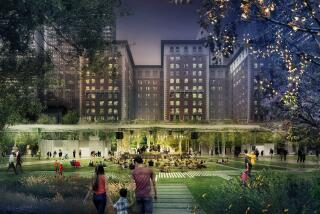Residents Breathe Deep as Mexico City Park Reopens
MEXICO CITY — Loud. Trashy. Crowded. Chaotic.
In recent years, that was many visitors’ lasting impression of Chapultepec Park, the massive green space that has served as an urban oasis here since the days of the Aztec empire.
For many inhabitants of this stressed-out city, one of the largest in the world, Chapultepec is practically the only large public refuge from the grind of daily life. But over the decades, the park itself had become part of the problem. Noisy and rundown, it was filled with shabby trees, scummy lakes and fountains, and sidewalk vendors peddling junk food and tchotchkes.
So when a large section of the park reopened Sunday after an expensive, eight-month makeover, for many Mexicans it was as if an old, haggard friend had just returned from a spa looking years younger.
“It was one of the happiest days of my life,” said German Dehesa, 60, a founder of the trust fund that organized the campaign to restore the park and a columnist for the Mexico City newspaper Reforma.
“I knew the beautiful Chapultepec of my childhood,” Dehesa said Monday. “And it has returned as a place for the people.”
Closed since October, the park underwent a $12-million restoration that included dredging lakes, pruning and removing trees, picking up tons of debris and expelling hundreds of the vendors whose carts and stalls used to clutter the pathways.
A crowd estimated at 150,000 attended the afternoon reopening, among them the mayor, Andres Manuel Lopez Obrador. City officials said more than 2 million people and 200 businesses helped pay for the park’s rehabilitation, which also received public funding.
The crowd started forming early in the morning, a sign of the collective pent-up desire to reconnect with the park. Long lines formed to rent rowboats for paddling on Chapultepec’s lakes. Every seat was taken on the trencito, or little train, that offered free rides for the afternoon.
Old men played chess on shaded picnic tables. Joggers grunted past rows of neatly trimmed bushes. One woman pitched a hammock between a pair of trees.
Sisters Alejandra and Sandra Fernandez Martinez, along with several other family members, were enjoying the vistas along the Avenue of the Poets, a quiet lakeside lane lined with bronze busts of famous literary figures. The siblings agreed that the park was much improved.
“First, because they’ve cleaned up the lakes,” Sandra said.
The thinning of the ranks of vendors gladdened Alejandra.
“We couldn’t walk before because they’d always bother us,” she said.
But the sisters wished authorities would add more trees to replace those that had been removed. “It looks a little naked,” Alejandra said.
A 1,600-acre expanse in the heart of the city, Chapultepec claims to be the largest urban park in the Western Hemisphere. Its origins date to about 1450, when the Aztecs built an aqueduct to transport water from Chapultepec’s natural springs to their capital, Tenochtitlan, which is now Mexico City’s historic center. The park’s name derives from Aztec words for “grasshopper hill.”
In the 18th century, a castle was built there and the park became the home of the Spanish viceroys. During the Mexican-American War of the 1840s, young Mexican cadets made a legendary last stand at the site by throwing themselves off a wall rather than surrendering to the U.S. invaders.
A second phase of the park’s restoration, including a new botanical garden, is expected to be completed in 2007. Dehesa said one of his goals was to increase the size of the security force so Chapultepec could stay open all day and night.
“It’s absurd that at 6 in the afternoon, when many people want to run, want to stroll, want to meditate a little, want to arrange a romance -- whatever they want to do -- they encounter it closed,” he said.
Still, not everyone is enamored of the park’s alterations.
“I don’t like it,” said Mario Palestina Nava, 68. He sat with his wife, Juana Ayala Guerrero, 64, by a wading pool.
In the past, he said, the park looked much greener and fuller than it does now. But Ayala allowed that the park was much cleaner and its pathways easier to amble along.
Would they return soon? Palestina shrugged. The crowds were bound to keep growing with the park’s restoration.
“The whole world wants to come,” he said, with what sounded like a touch of pride.
More to Read
Sign up for Essential California
The most important California stories and recommendations in your inbox every morning.
You may occasionally receive promotional content from the Los Angeles Times.











